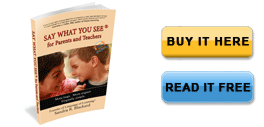Fight-Flight-Freeze: A Natural Ladder from Anxiety to Freedom

Our fight-flight-freeze response is much maligned.
An article in Psychology Today says this "survival-oriented acute stress response" offers three options that amount to: battle, escaping, or becoming paralyzed and "numbing out." All three have negative connotations in our culture; and since none rely on reason, no wonder we see this fight-flight-freeze response as a primitive piece of mental programming we should try to overcome.
Some people put a lot of effort into overcoming it especially in anxious moments where the threat is imagined. But what if the response itself were the way out?
In my post What's Perfect About Perfectionism—Part 3 I talk about how to find the perfection in anything, so I turned my sights on these pieces of programming we are born with. What I discovered was that the perfection in the fight-flight-freeze response goes well beyond helping us survive physical threats. In the case of imagined threats, rather than perpetuating anxiety, it may even be able to help us return to our natural state of rational calm, if we can change how we see it.
As we know, animals use this response very effectively in the wild to survive and have no trouble returning to their natural state of calm. Even if our fears are in our minds, it should work for us, too. Maybe it could if we could find a way to embrace it rather than fight it.
Did you see that word, "fight?" If you normally fight something, that tells you that you see it as a threat! The perception that the fight-flight-freeze response itself is a threat can perpetuate your anxiety.
To find a new perspective, I looked at the fight-flight-freeze response through the lens of the Three Basic Needs, one of our Language of Listening® coaching tools. What I saw surprised me. It seems that all three responses have something in common—they all meet our need for power. How?
Control.
When we feel threatened or powerless, there are three things we can control:
- Control the threat—FIGHT
- Control our environment—FLIGHT
- Control ourselves—FREEZE
I had to blink twice when I saw how perfectly they line up. Notice how the focus of your control moves from external to internal the less powerful you feel in your situation, and from internal to external the more powerful you feel.
More than that, notice your reaction to the idea of fight-flight-freeze as ways to CONTROL a threat, your environment, and yourself. Controlling those things feels empowering, right? That makes the fight-flight-freeze response something you would never want to give up!
Let that sink in a minute, because when you get it, it can change everything!
This simple perspective shift offers new response options.
When you see that your automatic responses are already meeting your needs, you don't try to stop them or fight them. That would just perpetuate your sense of powerlessness and your fear. Instead, if you know they are already working for you, but you don't like the automatic actions you are taking, you get to choose new actions that meet those same needs in ways that you like better. That is the principle behind Language of Listening's CAN DOs.
So how might that play out in everyday situations?
FIGHT: Some children hit their parent when the parent sets a boundary they don't like. They feel controlled and threatened, so they puff up and try to control the parent. When a parent sees their children's fight response as a way to meet their need for power, the parent can offer other options that help their child develop self-control instead.
What works well for the parents I coach is facilitating, not stopping, the child's expressions of anger. Some ways to do this include offering their hand in high-five or low-five position for hitting; holding up a pillow saying, "You can hit this"; keeping a bop bag handy and calling the shots while the child hits it; etc.
Of course parents can't stop there. If children meet their need for power in the moment but still feel controlled, the fighting will just start over when the parent restates the boundary. To see how to use the three coaching skills I teach to facilitate a permanent shift from hitting to self-control, you can watch this video clip from my SAY WHAT YOU SEE® workshop. My book explains this and more.
FLIGHT: Some couples have a dynamic where during an argument one gets angry and storms off, and the other feels powerless and hurt thinking that walking away means their spouse doesn't care.
In one case, without the husband changing anything, this new perspective on what he was doing by walking away changed how the wife saw him. Now when he walks away, she sees him as controlling his environment to meet his need for power, so he can calm down and finish their conversation later...which is actually possible now when he returns because she isn't angry about him walking away.
Just like that, an offensive action became respectful in her mind! Plus now she can see he had always calmed down after leaving, but she couldn't put the two together when she thought of him as running away to avoid talking to her.
FREEZE: Some parents freeze in interactions with their child when faced with boundary-setting. If they are afraid of confrontation (fight), and can't just leave (flight) and let the child continue, they stay...paralyzed (freeze). Not only do they feel powerless in the moment, but they kick themselves later for being so weak, and worry that they will do it again...which of course they do. Feeling like their only other options are even worse (fight or flight), they have no choice and get stuck in the freeze cycle.
One parent I coached was visibly relieved when we talked about freezing as a way to meet her need for power by controlling herself. This new, perspective helped her see that sometimes standing silently was actually the right thing to do and resulted in her child actually stopping himself—something she had missed when caught up in her "freeze response."
It also helped her recognize that her child actually preferred stopping himself instead of being stopped by her...which is why he fought so hard when she tried...which is why she avoided confrontations with him...etc. You can see how this freeze cycle had been self-perpetuating.
Her new understanding of herself and her child revealed some new options. 1) Stating a boundary and waiting on purpose to allow the child the time he needed to stop himself. Waiting on purpose is a relatively easy shift when freezing is already your habit. However, the purposeful nature of it shows up in your presence and sends a different message to your child. It says you are the authority choosing to wait (not a victim being made to wait by the child).
Waiting on purpose also demonstrates respect for the child, which children respond to in kind, as does this: 2) Giving advanced warning before it's time to stop and change activities.
Both of these options create more opportunities for the child to stop himself, which are also opportunities to name STRENGTHs that keep the cycle of respect going: "All you needed was another minute and you stopped yourself. That shows self-control. You know what works for you!"
Power Ladder: Freeze-->Flight-->Fight:
In the case of anxiety, where you feel frozen or stuck in worry, you can even use the other two (flight and fight), as a ladder to pull yourself up to a more empowered level. Look back at your automatic response pattern and notice the kind of recurring thoughts you have, then map those onto your new fight-flight-freeze control model, create new options for yourself if needed, and do them on purpose!
Freeze-->Flight-->Fight
For example, in test-taking, if you see a question you don't know the answer to and stop and go blank, that's you controlling yourself and your mind (freeze). Blank keeps you from reliving your perceived failure. If you then look up from the test, maybe even towards the door, that's you mentally controlling your environment (flight). "Get me out of here" thoughts actually feel more powerful than blank ones because now you're imaging taking action.
If you knew that and followed your thoughts out the door on purpose, what would you imagine doing out in the hall? If you still felt powerless you might imagine kicking the wall and blaming the test, the class, the teacher, or yourself. Fighting anything or anybody that you think got you into this mess would be you controlling the threat (fight)!
Wherever your thoughts go, imagine more of that on purpose because by moving from internal to external images of control, you are meeting your need for power. It might be that after you control the threat in your mind, you'll feel powerful enough to take a big breath, return to the test, and find a problem you know, so you can experience a real-world success before moving on.
Escape Ladder: Freeze-->Fight-->Flight
If your automatic thoughts occur in the other order—blank (freeze), blame (fight), "I'm out of here" (flight)—what works for you might be better called an escape ladder. If so, do it on purpose.
After going blank, and blaming someone or something, when you finally mentally burst out the door, imagine yourself doing something you love or something you are really good at, the more powerful the scenario the better. Some kids imagine flying away like a bird, while others actually step from mental images to physical action and spin a pencil on their fingers. Whatever comes naturally to you, if you do it on purpose and see it as you reclaiming control, it will meet your need for power much faster and help you return to your work.
Start with your automatic responses, then do them on purpose in a way you like better—that would be you using freeze-flight-fight as a ladder back to your empowered self.
With a new perspective on how our natural fight-flight-freeze response works, rather than treating it like some primitive urge to overcome, you can use it to develop strategies for a more stress-free life. Fight-flight-freeze embraced!
Resources: For more ideas about what you or your child can do in anxious moments, read The Opposite of Worry by Dr. Lawrence Cohen.
Disclaimer: If you are seeking help for an anxiety disorder, please find a mental health professional. This blog is where I share my opinions, perspectives, realizations, insights, and breakthroughs as posts, which I hope will be helpful to you as a different way to look at life (different, not "right") and stimulate further thought. They are not intended as medical or mental health advice or in any way meant to replace the services of a mental health professional.





